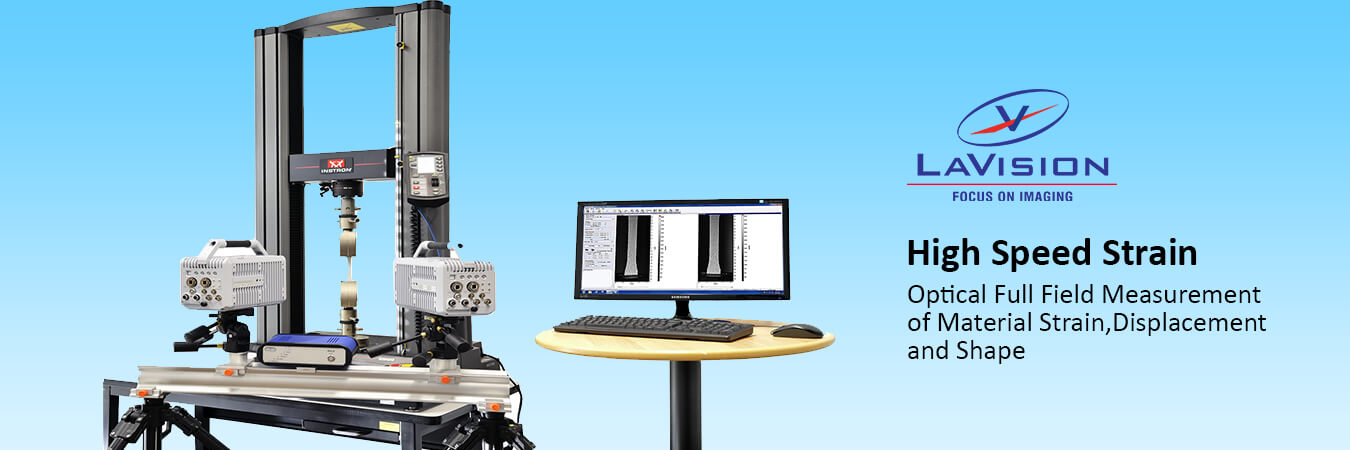
PRODUCTS & TECHNOLOGY
Digital Image Correlation (DIC) & Digital Volume Correlation (DVC)
Digital Image Correlation (DIC) is a 3D, full-field, non-contact optical technique to measure contour, deformation, vibration and strain on almost any material. The technique can be used for many tests including tensile, torsion, bending and combined loading for both static and dynamics applications.
The user acquires a series of images during a material testing experiment, with the first image normally being the case of zero applied load. With standard single camera or stereoscopic multi camera setups, 2D in-plane deformation or full 3D surface measurements are achieved. Local derivative calculations give the strain tensors across the entire surface, and a standard feature of StrainMaster is the ability to place a virtual strain gauge anywhere on the sample surface after the test, giving incredibly accurate strain data.
Digital Volume Correlation (DVC) is a related analysis method with close ties to 2D-DIC. 3D-DIC successfully maps 3D deformations, but it does so by capturing planar images of the surface of a body only. The DVC algorithm is able to track full-field displacement information in the form of voxels instead of pixels. The theory is similar to above except that another dimension is added, the z-dimension. Instead of minimizing a coefficient based on the summed difference of intensity values in a subset of a planar image, minimization is done in a 3D-subset where intensity values corresponding to (x,y,z) values are compared to a standard and the summed difference minimized using predictive, 3D displacement fields.
DVC can be done on any image dataset that represents a volume. Recently, the technique has been expanded by the development of confocal microscopy, which allows for the imaging and testing of live tissue samples with techniques such as Second-Harmonic Generation (SHG) and Two-photon excitation microscopy. DVC is currently considered to be ideal in the research world for 3D quantization of local displacements, strains, and stress in biological specimens. It is preferred because of the non-invasiveness of the method over traditional experimental methods. The DIC & DVC applications caters to broad range of applications which includes,
The user acquires a series of images during a material testing experiment, with the first image normally being the case of zero applied load. With standard single camera or stereoscopic multi camera setups, 2D in-plane deformation or full 3D surface measurements are achieved. Local derivative calculations give the strain tensors across the entire surface, and a standard feature of StrainMaster is the ability to place a virtual strain gauge anywhere on the sample surface after the test, giving incredibly accurate strain data.
Digital Volume Correlation (DVC) is a related analysis method with close ties to 2D-DIC. 3D-DIC successfully maps 3D deformations, but it does so by capturing planar images of the surface of a body only. The DVC algorithm is able to track full-field displacement information in the form of voxels instead of pixels. The theory is similar to above except that another dimension is added, the z-dimension. Instead of minimizing a coefficient based on the summed difference of intensity values in a subset of a planar image, minimization is done in a 3D-subset where intensity values corresponding to (x,y,z) values are compared to a standard and the summed difference minimized using predictive, 3D displacement fields.
DVC can be done on any image dataset that represents a volume. Recently, the technique has been expanded by the development of confocal microscopy, which allows for the imaging and testing of live tissue samples with techniques such as Second-Harmonic Generation (SHG) and Two-photon excitation microscopy. DVC is currently considered to be ideal in the research world for 3D quantization of local displacements, strains, and stress in biological specimens. It is preferred because of the non-invasiveness of the method over traditional experimental methods. The DIC & DVC applications caters to broad range of applications which includes,
- High Strain Rate Testing
- High Temperature DIC
- Ultra-fast Deformation Analysis
- Long term flow stress experiments
- Thermal Mechanical Fatigue (TMF) tests
- Strain field in Granular flow
- Strain Measurement of Ring Stent Wire
- Material Testing
- High Speed DIC applied to Blast Testing of Sandwich Composite Materials
- Simulation of Tectonic Deformation with Quantitative 3D Strain Analysis
- Computation of Full-field Displacements in a Scaffold Implant using Digital Volume Correlation and Finite Element Analysis
- Elastic Stiffness Characterization using Three-dimensional Full-field Deformation obtained with Optical Coherence Tomography and Digital Volume Correlation
- Comparison of the Mechanical Behavior of Standard and Auxetic Foams by X-ray Computed Tomography and Digital Volume Correlation
- Fluid-Structure Interaction Study: Towards Active Flutter Control of a Composite Wing
- Fluid-Structure Interaction Studies of Bioscience Subjects
- Lithiation-Induced Dilation Mapping in a Lithium-Ion Battery Electrode by 3D X-Ray Microscopy and Digital Volume Correlation
- The Application of Digital Volume Correlation (DVC) to Study The Microstructural Behavior of Trabecular Bone during Compression
- Vibration Analysis of Tuning Fork Oscillations using High-Speed DIC and many more…
Test Data
Test Data
Test Data
Test Data
Test Data
Test Data
Test Data
Test Data
Test Data
Test Data
Test Data
Test Data
Test Data
Test Data
Test Data
Test Data
Test Data
Test Data
Test Data
Test Data
Test Data
Test Data
Test Data
get in touch
Ut enim ad minim veniam, quis nostrud exercitation ullamco laboris nisi
ut aliquip ex ea commodo consequat.
Test Data
+91 987 654 3210
No.18, 9th main,
5th cross, Kalkare Cross,
Bangalore-560067


